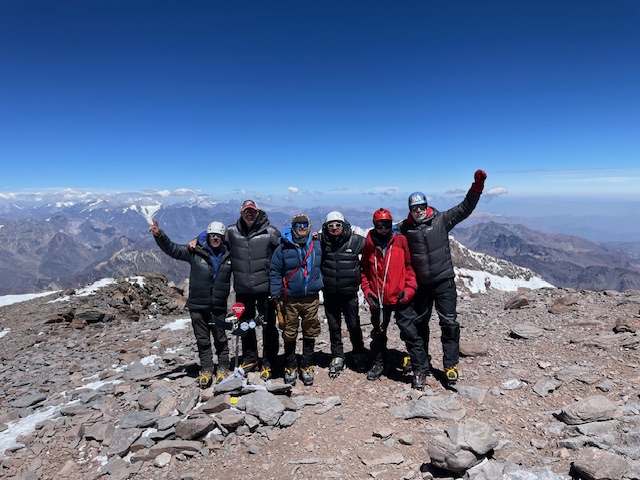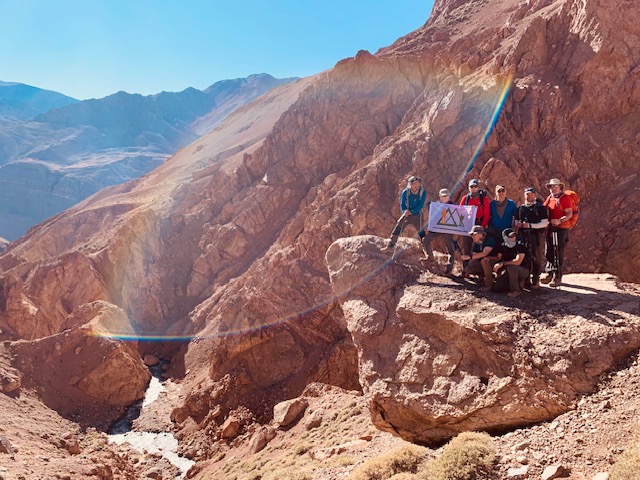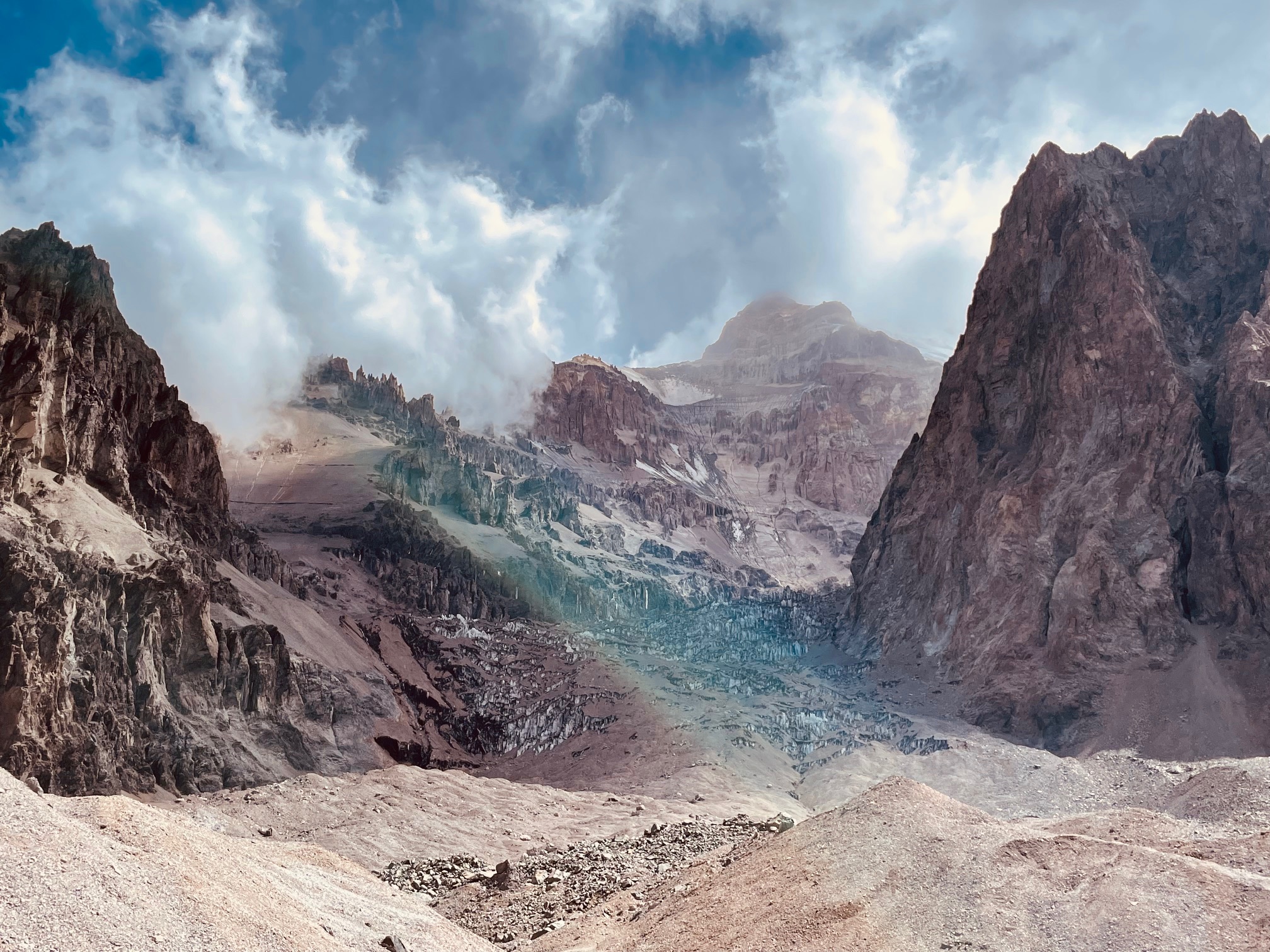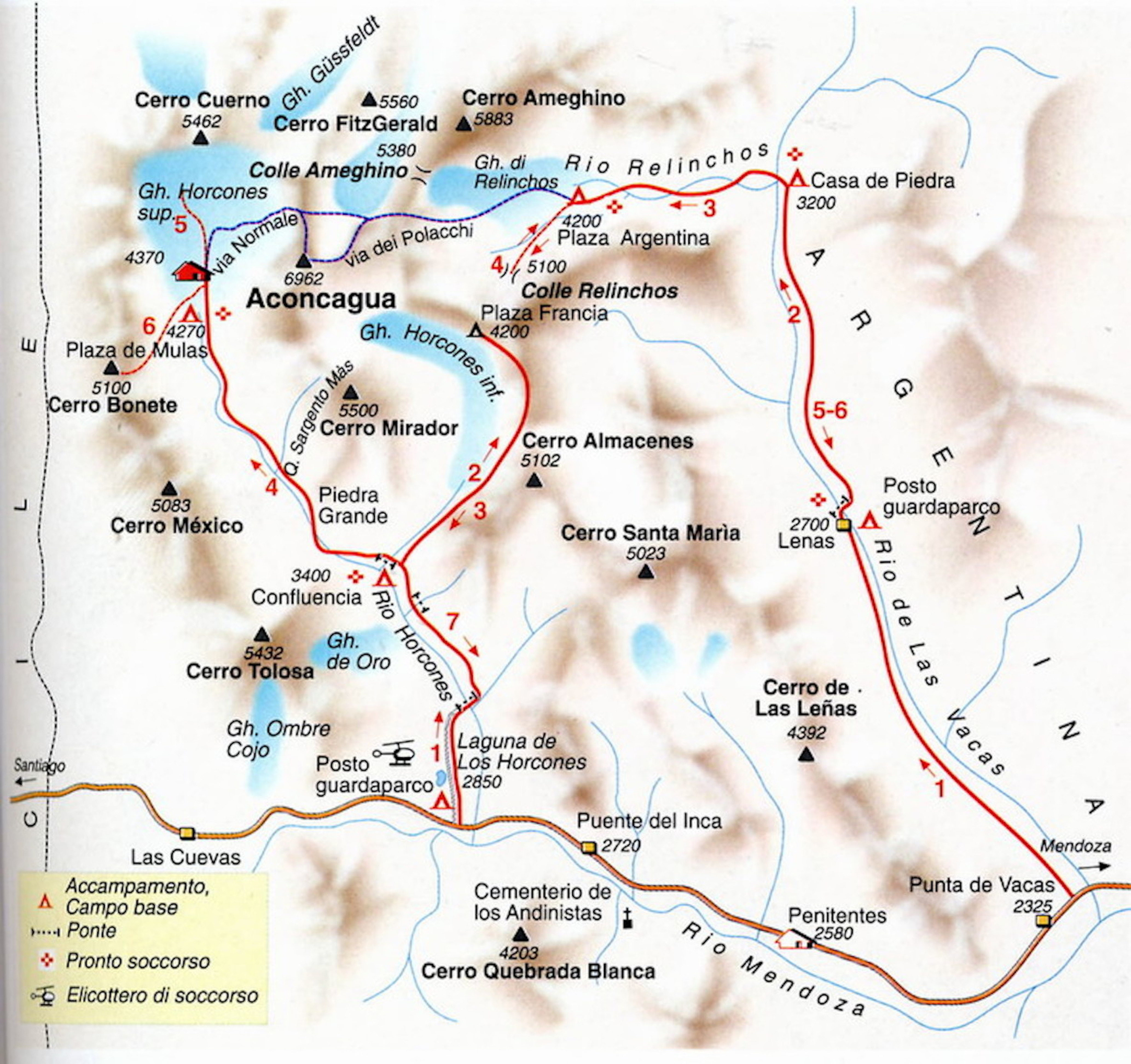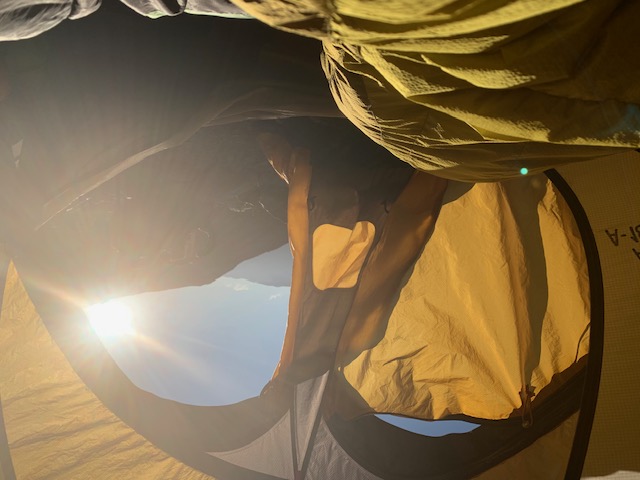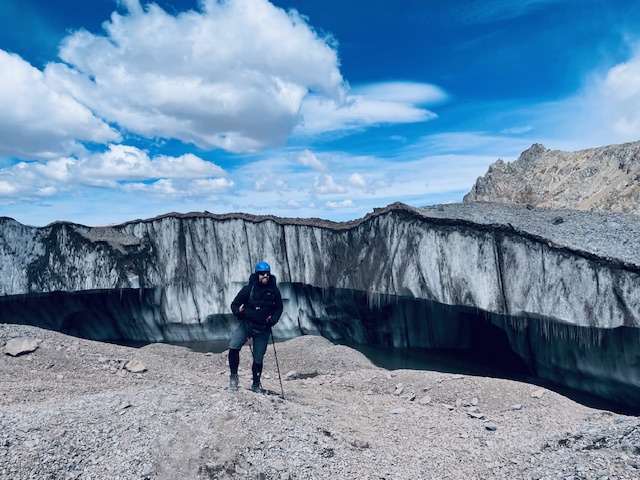The Big Aconcagua questions, should I take the Normal Route or Traverse Route? Or take on the Polish Glacier route. What is your goal on Aconcagua. Experience as much of the mountain as possible. Are you trying to make the challenge harder for an even bigger climb? Looking for the easiest way up and down the mountain? Are you testing your gear for future trips or gain more high altitude experience? Schedule a call and check out our upcoming trips.
Aconcagua: Lets be clear!
No matter what route you choose, Aconcagua is a beast. If you like analogies’ Kilimanjaro is a 10 miler, Aconcagua is a marathon. Aconcagua has harsh weather, high winds, extreme altitude along with challenging terrain especially high on the mountain. You need excellent acclimatization and the physical conditioning to match that.
The Vacas Valley Traverse Route
The Vacas valley route, or the Polish traverse route are the same route. If you are seeking a unique and less crowded ascent up Aconcagua? Delve into the world of the Polish Traverse Route, an exhilarating alternative to the bustling Normal Route through Horcones Valley.
Referred to as the “360-Route” due to its circumnavigation of Aconcagua, this journey offers a distinct adventure for seasoned climbers. With lots of pros there is a con, in that you have to carry more expedition equipment on the Traverse route. There is an option of having additional porter support above Base Camp on the traverse route.
3 Reasons to Pick the Vacas Valley Route
1). Less people: The route into Plaza Argentina Base Camp is more interesting and has less people. Depending on your perspective and experience this could be a major draw. You may want easier more direct access to Aconcagua, if so, the normal route will be for you.
2). More Sun: Plaza Argentina Base Camp on the Vacas Valley route or traverse route is warmer. This Base Camp gets early morning sun to warm up your tent. For me this makes a big difference as you start your day on this side of Aconcagua.
3). Better Scenery: The traverse route has more interesting scenery. The trek in offers better vistas. The route over the glacier to Camp 1 and views of Aconcagua in this areas are amazing. The overall mountain viewing experience as you traverse Aconcagua is simply better than the normal route.
The Normal Route on Aconcagua
From the road side close to Puente del Inca you can see the stunning south face of Aconcagua. The access to Base Camp is 15 miles from here. This offers a more direct route into the Base of Aconcagua. From Plaza de Mulas Base Camp you have the shortest ascent route, which attracts more people to the normal route up Aconcagua.
The normal route has three camps above Base Camp, similar to the Vacas route but the distances and elevations are a little less. Our Base Camp in Plaza de Mulas sits at 4,390m/ 14,403 feet. Base Camp at Plaza de Argentina sits at 4,200m/ 13,780 feet.
3 Reasons to Pick the Normal Route
1). More Direct: The distances on the normal route are less than the Vacas Valley Route. On the normal route up Aconcagua you have less distance between camps and more straight forward terrain up to Camp 3 where the route meet.
2). Easier Access: You can get from Base Camp to the road in one day. This is not possible on the traverse route. This makes access to and from Plaza du Mulas Base Camp as easier objective.
3). Carry less weight: On the normal route you just have to carry your personal gear above Base Camp. On our trips you don’t have to carry additional expedition food, fuel and equipment that you have to carry on the Vacas Valley. For an additional $1,400 you can have all your personal expedition gear carried through the camps to Camp 3 and back to Base Camp. This is more expensive on the traverse route.
Aconcagua: The Normal Route Verses Polish Traverse Route
Unlike its counterpart, the Polish Traverse Route veers away from the masses, providing a quieter, more immersive experience amidst the towering peaks. Over the span of 16 years and 10 expeditions, I’ve explored both routes extensively, uncovering the nuances that set them apart.
The Polish Traverse, Vacas Valley route, also known as the False Polish Glacier Route, beckons with its stunning vistas and challenging terrain. Unlike the Normal Route, which traverses through Horcones Valley, the Traverse takes a longer, more scenic path, avoiding the glacier hike while still offering comparable climbing experiences.
Where do the Routes Meet
The Normal Route meets the traverse route at Camp Colera 5,990m/ 19,652 feet. From here the route join for the summit day. After navigating through the Traverse’s unique challenges, climbers reconvene with the Normal Route for the final ascent. After the summit attempt you will complete the full circle down the normal route on Aconcagua.
For those seeking a quieter expedition with fewer fellow climbers, the Polish Traverse presents an enticing option.
The Most Popular Aconcagua Route
While the Normal Route remains the most popular choice among climbers, the Polish Traverse offers a refreshing alternative for those craving a more secluded adventure. With its fewer expeditions and distinct challenges, this route promises a truly memorable ascent up Aconcagua’s majestic slopes.
Which Route is for me?
Whether you’re an experienced mountaineer or embarking on another 7 summit, choosing the right route is crucial for a safe and fulfilling journey. Consider the unique features and differences between the Polish Traverse and Normal Route, and embark on an adventure tailored to your preferences and aspirations.
As you plan your Aconcagua expedition, prioritize acclimatization and safety, ensuring you’re adequately prepared for the rigors of high-altitude climbing. With proper training, equipment, and previous experience we can help you reach new heights.
What is the Hardest Route on the Aconcagua?
The Polish Glacier route is a technical climbing route that requires fixed lines is one of the most difficult routes on Aconcagua and is climbed by a minority of the teams. We do not offer this route to our clients. The glacier has 50 to 70 degree angled snow and ice slopes requiring technical ice climbing skills.
How hard is Aconcagua compared to Kilimanjaro?
It’s essential to recognize that Aconcagua presents an objectively bigger challenge compared to Kilimanjaro. With a higher altitude, longer duration, more adverse weather conditions, and technical elements involved, ascending Aconcagua requires a higher level of physical and mental fortitude.
What is the Easiest Route to Climb Aconcagua?
The Normal Route is considered the easiest route. You carry less weight on the normal route. This route is easier to access and the route is more established on a more direct route to the summit with less distance to cover.
Should I Take Diamox on Aconcagua?
The general consensus of the research is that Diamox is helpful in avoiding AMS. We recommend you consider taking Diamox when climbing Aconcagua. It is important to make sure you are not allergic to sulfa’s.
You should seek medical advice as it is a prescription drug, and you should consult with your doctor before taking it. There are alternatives to consider. You also want to carry Ibuprofen as a tried and test drug for reducing inflammation at High altitude.
How Fit do you Need to be to Climb Aconcagua?
Fitness is a relative term. Are you running a Marathon or climbing a mountain. Training for steep trekking and mountaineering focuses on building a sport-specific fitness developing cardiovascular endurance training, flexibility, and strength training.
The training information here will help you arrive prepared for the mountain. Most people will need to train for an Aconcagua climb for at least 6 months out, if not more.
What mountains should I climb before Aconcagua?
There are a range of mountains you should have climbed before attempting Aconcagua. We recommend taking on Kilimanjaro or Elbrus. We also highly recommend having climbing Cotopaxi and Chimborazo and peaks like Lobuche or Mera peak in Nepal. The reason for this is you need to build experience at high and extreme altitude, in a wide range of conditions and situations and these mountains offer this mix.
Where does Aconcagua Rank?
Aconcagua is one of the Seven Summits, the highest peaks on each of the seven continents. It is second in height after Mount Everest. In terms of where Aconcagua ranks in the seven. It would be the third hardest after Mount Everest and Denali, North America’s highest peak.
Do you need an ice axe for Aconcagua?
In recent years an Ice axe has been needed high on the mountain. On the day of our ascent to the summit of Mount Aconcagua, we recommend carrying a lightweight ice axe. We recommend a certain type of axe and size and this will be listed in our 40 page document we send you on signing up. We may not need an ice axe and this will depend on the conditions and the amount of snow on the mountains at the time you are there.
Why Does Aconcagua take so long?
People wonder why they can climb Kilimanjaro in 8 days and Aconcagua takes 19 or 20 days. Remember there is a big different in going to high altitude and staying at high altitude. Kilimanjaro allows you to stay below 3,900m/ 12,800m before moving higher and getting back to low altitude pretty quickly.
Aconcagua Base Camp is already above 4,000m/ 13,123 feet. You then have to acclimatize to higher altitudes above 5,000m/ 16,404 feet. This requires more time to allow the body to create more red blood cells so you can perform higher on the mountain. Your body need to be acclimatized in this unforgiving place that make it a serious challenge even for experienced mountaineers.
What Makes Aconcagua Unique?
Aconcagua is the highest mountain in the Americas and the tallest mountain in the world outside of the Himalayas. Located in the Andes Mountains of Argentina, near the city of Mendoza, Aconcagua has been luring European mountain climbers since 1883. Aconcagua, one of the illustrious seven summits, beckons adventurers worldwide, drawing them to its formidable slopes in pursuit of conquering this towering behemoth.
Aconcagua with Experts
We have managed treks to Aconcagua for over 15 years with great success. Our partnership with a local team, providing quality tents, services and facilities along with Ian Taylor Trekking experts on the ground offer you the highest level of safety for your Aconcagua expeditions.
Ian is also available 5 days a week in support of your trip, so you can gain access to someone who has climbed Aconcagua 10+ times. Get in touch and get signed up for one of our Aconcagua treks.
I hope this information, Aconcagua: The Normal Route Verses Polish Traverse Route was useful as you prepare for your Aconcagua Expedition.

